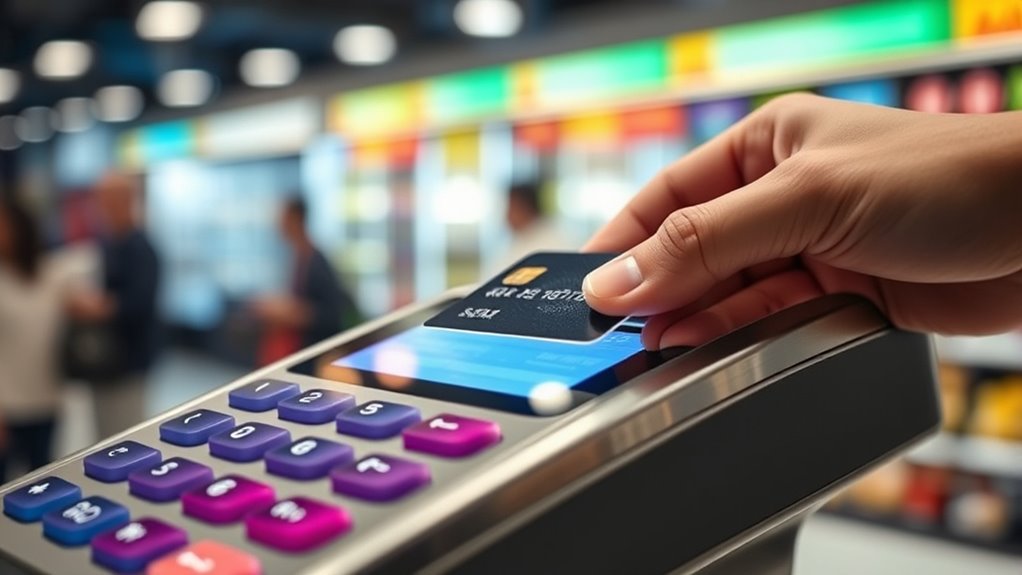Payment tokenization reduces chargebacks by replacing your sensitive payment info with secure digital tokens, making it harder for fraudsters to steal your data. It creates a safer environment for transactions, limiting the damage if breaches happen. By ensuring that stolen tokens are useless outside their specific context, it prevents unauthorized charges. This layered security keeps customer trust high and risks low—continue to explore how this powerful strategy can protect your business even further.
Key Takeaways
- Tokenization replaces sensitive card data with unique digital tokens, preventing fraudsters from accessing usable payment information.
- It creates a secure transaction environment, reducing the likelihood of data breaches that lead to chargebacks.
- Tokenized transactions offer clear, tamper-proof records, simplifying dispute verification and reducing false chargebacks.
- Enhanced security measures like multi-factor authentication and real-time monitoring catch fraudulent activity early.
- Overall, tokenization minimizes payment data exposure, strengthening fraud prevention and decreasing chargeback incidents.

Payment tokenization has become a crucial tool in reducing fraud and enhancing security in digital transactions. When you implement tokenization, sensitive payment information is replaced with a unique digital token, making it much harder for cybercriminals to access or misuse your data. This process not only strengthens your overall security but also directly impacts your ability to prevent chargebacks caused by fraudulent transactions. By reducing the exposure of actual card details, tokenization acts as a key component in your fraud prevention strategies, helping you safeguard your business and your customers.
One of the main benefits of payment tokenization is its ability to improve cryptocurrency security. As digital currencies become more popular, the risk of theft and fraud increases. Tokenization creates a safer environment by ensuring that even if a breach occurs, the stolen tokens are useless outside their intended context. This limits the damage that hackers can cause, decreasing the likelihood of unauthorized transactions that lead to chargebacks. When you use tokens instead of real card or crypto wallet information, you minimize the risk of your payment data being compromised, which is essential in today’s ever-evolving digital landscape.
Furthermore, tokenization simplifies the dispute process, which can considerably reduce chargebacks. When a transaction is tokenized, the details stored are less susceptible to manipulation or fraud, making it easier for you to verify legitimate transactions. If a customer disputes a charge, having a clear, token-based trail helps you quickly demonstrate that the transaction was authorized and secure. This not only streamlines your dispute resolution process but also reduces the chances of losing revenue due to chargebacks. As a result, your business benefits from better cash flow and less time spent resolving fraudulent claims.
Implementing robust fraud prevention strategies alongside tokenization further enhances your defenses against chargebacks. Techniques like real-time transaction monitoring, machine learning algorithms, and multi-factor authentication work in tandem with tokenization to detect suspicious activity early. This proactive approach allows you to intercept potentially fraudulent transactions before they are completed, saving you from costly chargeback fees and reputational damage. By integrating these strategies, you create a layered security system that makes it considerably harder for fraudsters to succeed, ultimately protecting your revenue and customer trust.
Frequently Asked Questions
How Does Tokenization Impact Transaction Speed and Latency?
Tokenization improves transaction speed and reduces latency by replacing sensitive data with secure tokens, streamlining processing. Encryption protocols ensure data remains protected during transmission, while data masking prevents exposure of actual details. As a result, transactions move faster since systems handle tokens instead of full data, minimizing delays. This efficient process enhances user experience and reduces the risk of data breaches, making payments both quicker and more secure.
Are There Any Industry Standards for Implementing Tokenization Securely?
Did you know that over 80% of payment security breaches could be prevented with proper standards? Industry standards like PCI DSS guide secure tokenization implementation, ensuring encryption protocols are robust and compliance standards are met. Following these guidelines helps you protect sensitive data, reduce fraud, and securely process transactions. Adopting recognized standards is essential for maintaining trust, minimizing risk, and implementing tokenization securely in your payment systems.
Can Tokenization Be Integrated With Existing Payment Systems Easily?
You can integrate tokenization with your existing payment systems, but it requires careful planning, especially if you’re working with legacy systems. The process involves updating your infrastructure to support tokenized data, which might pose compliance challenges like meeting PCI DSS standards. To facilitate a smooth transition, consider leveraging middleware solutions or partnering with providers experienced in seamless tokenization integration, reducing potential disruptions and maintaining secure, compliant payment processes.
What Are the Long-Term Cost Implications of Using Tokenization?
Using tokenization can lower your long-term costs by reducing fraud-related expenses and chargebacks. While the initial cost analysis might seem high, you’ll save money over time through enhanced fraud prevention and fewer disputed transactions. Plus, tokenization minimizes the risk of data breaches, which can be costly. Overall, investing in tokenization often results in more predictable expenses, helping you maintain a more secure and cost-efficient payment system long-term.
How Does Tokenization Affect Customer Experience and Trust?
Imagine a world where your customers feel more confident during checkout—that’s what tokenization creates. By enhancing data security, you build strong customer trust, making transactions smoother and more reliable. When sensitive info is replaced with tokens, customers know their info stays safe, reducing anxiety and fostering loyalty. This seamless experience encourages repeat business, showing that safeguarding data directly boosts customer confidence and long-term satisfaction.
Conclusion
Think of payment tokenization as a sturdy fortress guarding your treasure. Just as a fortress shields valuables from invaders, tokenization keeps sensitive payment data safe from fraudsters. By transforming your information into unreadable tokens, you reduce the risk of breaches and chargebacks. When you treat your transactions like precious cargo protected by an unbreakable wall, you create a secure passage that discourages attacks and preserves your peace of mind. Ultimately, tokenization is your fortress in the battle against chargebacks.










